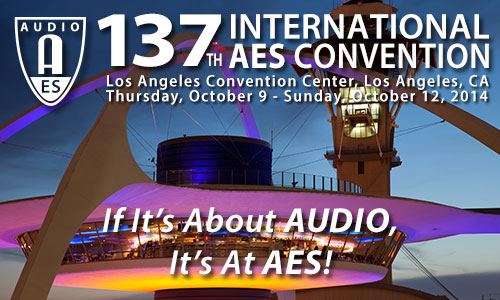
AES Los Angeles 2014
Engineering Brief EB1
EB1 - eBriefs—Poster Session 1
Thursday, October 9, 11:00 am — 12:30 pm (S-Foyer 1)
EB1-1 Analysis of Sound Field Generated by Line Arrays with Waveguides—Xuelei Feng, Nanjing University - Nanjing, Jiangsu, China; Yong Shen, Nanjing University - Nanjing, Jiangsu Province, China; Simiao Chen; Ye Zhao
Considering that a loudspeaker line array results from assembly of separate loudspeaker enclosures, it is important to take the gaps between enclosures into account and the line array is considered as a collection of several line sources of certain height. Particularly at high frequency, since the waveguides are used as the array element to achieve the line sources, the sound field generated by the arrays of waveguides is analyzed. The results are compared with those described in previous works that assumed that the array elements were perfect line sources.
Engineering Brief 156 (Download now)
EB1-2 Active Noise, Acoustic Echo, and Audio Ducking Using TMSC5535 eZdsp USB Stick Development Kit—Name Withheld, Removed at the request of the presenter.
Audio Ducking, Active Noise and Acoustic Echo Cancellation using TMS320C5535 eZdsp USB Stick Development Kit is an application system designed for live audio broadcasting and recording purposes. This application system initializes and executes adaptive audio and acoustic signal processing algorithms using a high performance and low power DSP TMS320C5535. In this study three sub-systems are discussed in brief and finally system setup and implementation is analyzed.
Engineering Brief 157 (Download now)
EB1-3 Loudspeaker Electrical Impedance Measurements Methods: A Brief Review—Daniele Ponteggia, Audiomatica Srl - Firenze (FI), Italy
There are several possible methods to measure the loudspeaker driver electrical impedance. Those methods have followed the development of measurement instruments starting from the era of the simple needle voltmeters to the PC based instruments widely available today. This paper will go through the theory and practice of impedance measurements with a series of examples where the pros and cons of each method are highlighted using real measurements. Effect of current sensor choice, noise, vibrations and test level will be discussed in detail.
Engineering Brief 158 (Download now)
EB1-4 Sound Field Intensity Measurements and Visualization around the Human Head Model—Bozena Kostek, Gdansk University of Technology - Gdansk, Poland; Audio Acoustics Lab.; Adam Kurowski, Technical University of Gdansk - Gdansk, Poland; Piotr Kryger, Gdansk University of Technology - Gdansk, Poland; Andrzej Czyzewski, Gdansk University of Technology - Gdansk, Poland
The main goal of this research study was to measure and visualize sound field in the presence and without presence of the human head model. Measurements were performed in the anechoic chamber at 5 cm grid. Experimental setup consisted of a multitone generator, two loudspeakers, human head model, intensimetric probe, the Cartesian robot applied for precise positioning of the acoustic sensor, and an analyzer. Based on the collected data sound field visualization was created in the form of colored maps and arrows illustrating pressure and the intensity vector at a given point in the presence of the artificial head, without this obstacle and the difference resulted from the mentioned conditions. A thorough analysis of the results obtained and conclusions followed.
Engineering Brief 160 (Download now)
EB1-5 Stereo Aligned Saturation—Quintino G. Sardo, SKnote - SK Cooperativa - S. G. La Punta (CT), Italy; Angelo Mangano, SKnote - SK Cooperativa - La Punta (CT), Italy
All analog devices provide a finite dynamic range. Saturation occurs when available headroom ceiling is reached. Often, saturation is a desired effect to provide punch, brightness or changes in timbre, but stereo image is compromised because stereo saturation cannot be matched. Tests and methods for stereo aligned saturation are analyzed and described.
Engineering Brief 174 (Download now)
